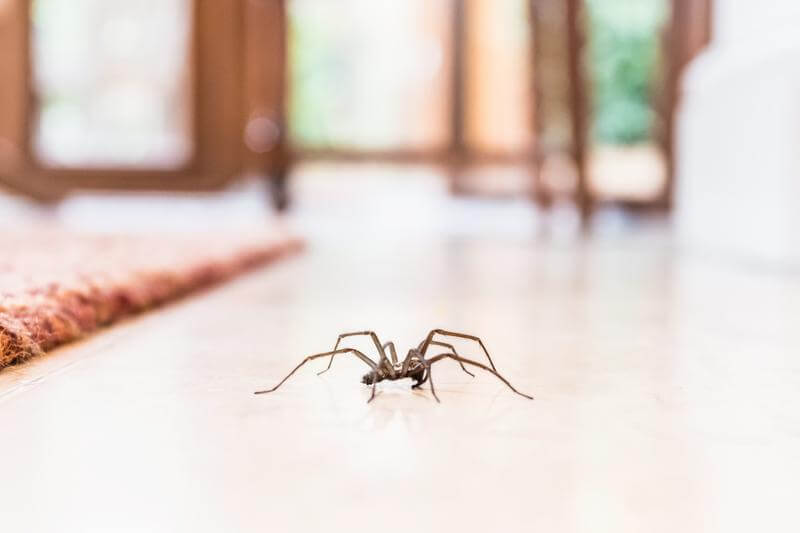The average American home has over 100 different species of bugs living inside.
Forty percent of the population has a phobia of bugs, with the large majority fearing spiders. While most of these bugs are harmless, that doesn’t reduce the ick-factor of having them in your home.
Read below to discover the top 10 spider prevention tips you need to know about.
1. start with your home’s exterior
The first step towards spider control is not giving them access to your house.
Start by sealing any cracks or holes found on the exterior of your home. Look for openings near your vents, pipes, windows, and doors. Use caulk in these small openings and cracks. Use a latex-based caulk so that you can paint over it to match the exterior of your home.
Once you’ve filled any access points, move debris away from your home. Spiders love to hide in piles of leaves, grass clippings, or woodpiles. These items serve as an invitation to pests to move into your warm, dry home.
2. spray pesticides in cracks or crevices
Use pesticides inside and outside your home to kill and prevent spider infestations.
For pesticides to be effective, the spider needs to come in direct contact with it. This is why you should spray pesticides in cracks or crevices where they may live. Small areas will force the spider to interact with the pesticide, leading to their death.
There is no clear answer for the best pesticides for spiders. Some people opt for powerful chemical pesticides to immediately stop the problem. Other people prefer natural pesticides that aren’t harmful to pets or children.
3. use spider traps
Glue or sticky traps work by capturing the spider and not letting go.
The great thing about these is that they capture all bugs that come across them, not only spiders. Having other bugs trapped will help attract more spiders to the trap.
Place the spider traps in a dark, quiet place and wait for the results. By monitoring the results, you’ll figure out where in your house the spiders prefer.
4. go for the contact kill
One of the best ways to get rid of a spider is to kill it. Grab a shoe or a book and squash the little pests. While the clean-up may be messy, you guarantee the spider’s death.
A fly swatter comes in handy to help reach spiders in high corners or hard to reach locations.
Pesticides and traps only work if the spider comes in contact with it. By killing the spider, you are sure the spider is dead. The contact kill only works if your spiders live in visible areas.
5. try essential oils
Essential oils offer a safe, natural option for spider prevention. These strong scents repel spiders and prevent them from entering your home.
Try a few of these essential oils for the best results:
- Citronella
- Peppermint
- Tea tree
- Rose
- Lavender
Use essential oils as an indoor spider repellent. Use these essential oils in an oil diffuser for even and constant distribution.
6. get rid of their food source
Spiders can only live where they have an ample supply of food. Spiders feed on other insects inside your home. Some of their food sources include earwigs, flies, mosquitoes, and moths.
By working to get rid of all these other pests, you will also remove the spider’s food source. So look toward complete pest control and don’t concentrate on spiders.
It also helps to remove any spider webs as soon as you see them. Spiders feed on many insects that get caught in their webs.
7. create a natural spider spray
Besides essential oils, there are other natural options for spider prevention. Most of the ingredients you already have in your home. Start by mixing together:
- One cup of apple cider vinegar
- One cup of pepper
- One teaspoon of oil
- One teaspoon of liquid dish soap
You can put the mixture in a spray bottle. Then spray the mixture near your windows and doors. Apply the mixture every few days until you see the desired results.
8. adopt a pet
While it may be gross, pets love to eat insects and spiders.
Bringing a cat, dog, or reptile into your home will decrease your spider population fast. These animals will naturally hunt out any food source.
The pet will come with other upkeep and maintenance chores. But introducing a pet into your home helps with more than eating pests. Pets serve as a loyal companion and studies show they are good for your health.
9. place hedge apples
Hedge apples are an old secret to help prevent spiders inside your home.
Buy Hedge Apples at grocery stores or farmers market in the late fall or early winter months. Look for trees in your local neighborhood and ask to pick a few Hedge Apples for a free resource.
Choose Hedge Apples that are still green. Place them in dark spots like closets or under your sink. You can even put several in a bowl for a nice fall decoration.
If you have pets or children, place them somewhere safe. Always wear gloves while handling the apples. As they ripen, the apples release a milky substance that irritates the skin.
10. bring in the professionals
If you need help with your infestation, contact a spider exterminator.
These experts can provide quick and thorough results. Qualified service technicians will come to your house to provide results. An expert will they get rid of the spiders with professional products. They can also help determine the cause of your infestation.
Some pest control companies offer de-webbing services for outdoor structures and fences.
Be sure to check out testimonials of a possible exterminator before you hire them.
need more help with spider prevention?
The team at Natura Pest Control offers spider prevention in Washington and Oregon.
Our professional and licensed staff are happy to provide effective pest control solutions. Along with spider prevention, we also offer ant, flea, mice, rat, roaches, and wasp control.
Contact us to set up your spider prevention appointment today.



